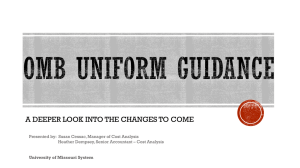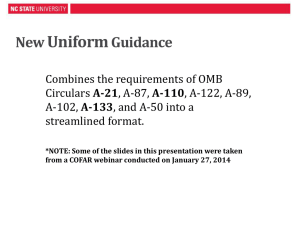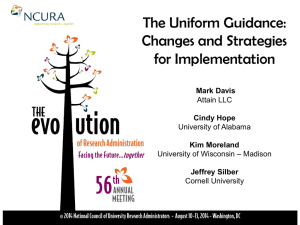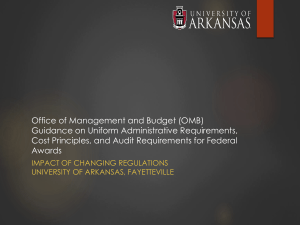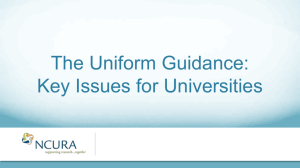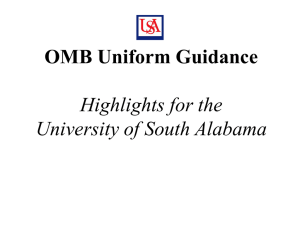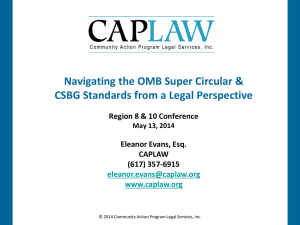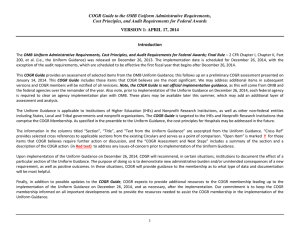What is the Uniform Guidance? - Appalachian State University
advertisement
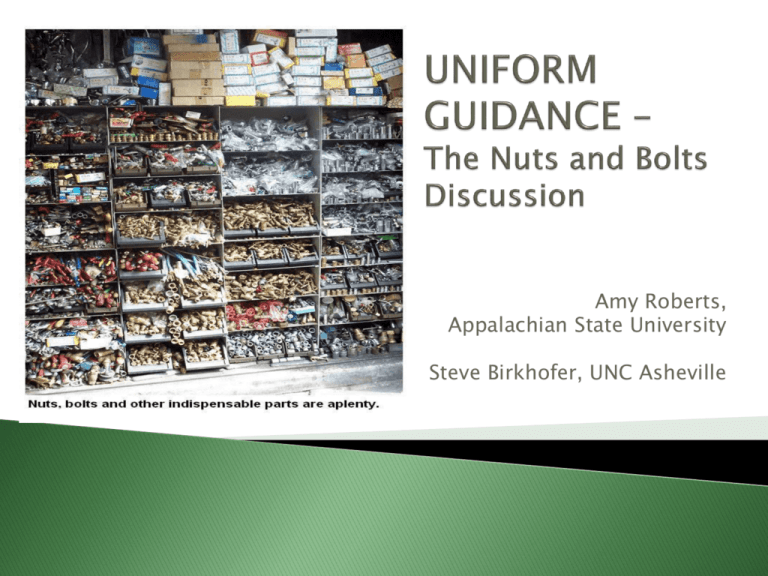
Amy Roberts, Appalachian State University Steve Birkhofer, UNC Asheville Originally referred to as A-81, the Super Circular, or the Omni Circular Consolidates 8 previous Circulars All Federal funding agencies are required to implement the Uniform Guidance. Included in the new guidance are definitions, uniform administrative requirements (both pre- and post-award), cost principles, and audit requirements. Administrative requirements and cost principles will apply to new and incremental funding awarded after December 26, 2014. Existing Federal awards will continue to be governed by the terms and conditions under which they were awarded. Subpart F, Audit Requirements, will apply to audits of non-Federal entity fiscal years beginning on or after December 26, 2014 ( or the first fiscal year that begins after December 26, 2014). From the university perspective, the Uniform Guidance will supersede OMB Circulars A110, A-21, and A-133. OMB Circular A-133 (Audits) OMB Circular A-110 (Administrative Requirements for Higher Ed, Hospitals and Non-Profits) OMB Circular A-21 (University cost principles) OMB Circular A-87 (State, Local and Indian Tribal Gov. cost principles) OMB Circular A-122 (Not for profit cost principles) OMB Circular A-89 (Catalog of Federal Domestic Assistance CFDA) OMB Circular A-102 (Grants and Cooperative Agreements with State and Local Government) OMB CircularA-50 (Audit follow up) Subpart A – Acronyms and Definitions Subpart B – General Provisions Subpart C – Pre-Award Requirements and Contents of Federal Awards Subpart D – Post Federal Award Requirements Subpart E – The Cost Principles Subpart F – Audit Requirements Appendices – I Funding Opportunities; II Contract Provisions; III Indirect Costs (F&A) +more! COSO – Committee of Sponsoring Organizations of the Treadway Commission COFAR – Council on Financial Assistance Reform EUI– Energy Usage Index FAIN– Federal Award Identification No. FAC– Federal Audit Clearing house FAPIIS – Federal Awardee Performance & Integrity Information System GOCO – Government Owned Contractor Operated IBS – Institutional Base Salary IHE– Institution(s) of Higher Ed PII– Personally Identifiable Information PRHP – Post Retirement Health Plans PTE– Pass through entity REUI– Relative Energy Usage Index SPOC – Single Point of Contact TFM – Treasury Financial Manual VAT – Value Added Tax 200.12 Capital assets - now includes intangibles: IP and software 200.20 Computing devices - machines used to acquire, store, analyze, process, and publish data and other information electronically, including accessories (or “peripherals”) for printing, transmitting and receiving, or storing electronic information 200.22 Contract - legal instrument by which a non-Federal entity purchases property or services needed to carry out the project or program under a Federal award unless transaction meets the definition of subaward. Focus on the nature of the relationship not what the agreement is called. 200.23 Contractor - entity that receives a contract as defined in 200.22 (Moving away from “vendor” terminology) 200.48 General Purpose Equipment now includes information technology equipment /systems 200.58 Information Technology Systems includes computing devices /software 200.61 Internal Controls -process designed to provide reasonable assurance regarding achievement of objectives: ◦ (a) Effectiveness and efficiency of operations ◦ (b) Reliability of reporting for internal /external use ◦ (c) Compliance with applicable laws and regs 200.67 Micro-purchase - a purchase of supplies or services using simplified acquisition procedures, where aggregate amount doesn’t exceed the micro-purchase threshold – currently $3k 200.75 Participant support costs -direct costs for items such as stipends or subsistence allowances, travel allowances, registration fees paid to or on behalf of participants or trainees (but not employees) in connection with conferences, or training projects. 200.80 Program Income - now includes license fees and royalties on patents and copyrights. The Federal awarding agency may negotiate agreements with recipients regarding appropriate uses of income earned after the period of performance as part of the grant closeout process. 200.94 Supplies - tangible personal property not described in as Equipment (200.33). A computing device is a supply if the acquisition cost is less than the lesser of the capitalization level established by the non-Federal entity for financial statement purposes or $5,000, regardless of the length of its useful life. 200.112 Conflict of interest - The Federal awarding agency must establish conflict of interest policies for Federal awards. The non-Federal entity must disclose in writing any *potential* conflict of interest to the Federal awarding agency or pass-through entity in accordance with applicable Federal awarding agency policy. 200.113 Mandatory disclosures - The non-Federal entity or applicant for a Federal award must disclose, in a timely manner, in writing to the Federal awarding agency or pass-through entity all violations of Federal criminal law involving fraud, bribery, or gratuity violations potentially affecting the Federal award. Failure to make required disclosures can result in any of the remedies described in §200.338 Remedies for noncompliance, including suspension or debarment. 200.210: Provides a standard set of 15 data elements which must be provided in all Federal awards either in full text or by reference Provides guidance on Federal Awarding Agency, Program, or Award Specific Terms and Conditions Requires Federal awarding agencies to include an indication of the timing and scope of expected performance as related to the outcomes intended to be achieved In some instances, (e.g., discretionary research awards) this may be limited to submission of technical performance reports 200.301: Provides more robust guidance to Federal agencies to measure performance in a way that will help the Federal awarding agency and other non-Federal entities to improve program outcomes, share lessons learned, and spread the adoption of promising practices. Federal awarding agencies must require recipients to use OMB-approved standard government-wide information collections to provide financial and performance information. Recipients must be required to relate financial data to performance accomplishments, and must also provide cost information to demonstrate cost effective practices. 200.303, Entities must: Establish and maintain effective internal control over the award to provide reasonable assurance that the entity is managing the Federal award in compliance with Federal statutes, regulations, and the terms and conditions of the award. Evaluate and monitor compliance Take prompt action on audit findings Safeguard protected personally identifiable information 200.306: For federal research proposals, voluntary committed cost sharing is not expected, and cannot be used as a factor during the merit review of applications or proposals, except where required by statute. May be considered if it is both in accordance with Federal awarding agency regulations and specified in a notice of funding opportunity. Only mandatory cost sharing or cost sharing specifically committed in the project budget must be included in the organized research base for computing the indirect (F&A) cost rate or reflected in allocation of indirect costs. 200.308: Prior approval to transfer from participant support costs Restriction on re-budgeting of training costs removed New language better reflects that project directors can be away from campus yet remain engaged in the project at proposed /awarded levels. Prior approval only required in the event that disengagement from the project occurs during the absence. “The disengagement from the project for more than three months, or a 25 percent reduction in time devoted to the project, by the approved project director or principal investigator” 200.313, Property records must be maintained that include: description of the property serial number or other identification number source of funding for the property (including FAIN who holds title acquisition date cost of the property % of Federal participation in the project costs for the award under which the property was acquired location, use and condition of the property any ultimate disposition data including the date of disposal and sale price of the property. 200.314: Title to supplies vest in the nonFederal entity upon acquisition. 200.453: Residual inventory of unused supplies > $5k at completion of the federal project and not needed for any other Federal award, can be retained for use on other activities or sold, but the federal government must be compensated for its share. The amount of compensation is computed in the same manner as equipment sold to 3rd party. 200.318(c)(1) - The non-Federal entity must maintain written standards of conduct covering conflicts of interest and governing the performance of its employees engaged in the selection, award, and administration of contracts. 200.318(c)(2) - new provision that covers organizational conflict of interest 200.319: Competition - The non-Federal entity must conduct procurements in a manner providing full and open competition, and that prohibits the use of statutorily or administratively imposed state or local geographical preferences in the evaluations of bids or proposals, except in those cases where applicable Federal statutes expressly mandated/encouraged. Methods of procurement to be followed – Includes a prescriptive list of 5 procurement methods (a) Procurement by micro-purchases (b) Procurement by small purchase procedures. (c) Procurement by sealed bids (formal advertising). (d) Procurement by competitive proposals. (f) Procurement by noncompetitive proposals. Procurement by micro-purchase: acquisition of supplies/services <$3k. To the extent practicable, the non-Federal entity must distribute micro-purchases equitably among qualified suppliers. Micro-purchases may be awarded without soliciting competitive quotations if the non-Federal entity considers the price to be reasonable. New category of micro-purchase which appears to allow purchases of up to $3k without competition Implication: purchases > $3k would have to be competitive – what about P-Card purchases > $3k??? Methods of Procurement - Noncompetitive proposals – revised to clarify that solicitation of a proposal from only one source may be used only when one or more of the following apply: The item is available only from a single source The public exigency or emergency for the requirement will not permit a delay resulting from competitive solicitation The Federal awarding agency (or pass-through entity) expressly authorizes this method in response to a written request After solicitation of a number of sources, competition is determined inadequate 200.330: Pass-through entities must determine when agreements made for disbursement of Federal program funds casts the party receiving the funds in the role of subrecipient or contractor Contractors: Contract executed to obtain goods and services for the non-Federal entity’s own use and creates a procurement relationship with the contractor Provide goods and services within normal business operations, normally in a competitive environment Provide similar goods and services to many different purchasers Provide goods /services ancillary to the operation of the Federal program Not subject to compliance requirements as a result of the agreement Subrecipients: Carry out a portion of a Federal award/creates a Federal assistance relationship Entity is eligible to receive Federal assistance Performance measured in relation to whether objectives of Federal program met Has responsibility for programmatic decision making Must adhere to applicable Federal program requirements specified in award Uses the Federal funds to carry out a program for a public purpose specified in authorizing statute, as opposed to providing goods and services for the benefit of a pass-through entity 200.331(b): Must evaluate subrecipients risk of non-compliance with Federal statutes, regulations, and terms and conditions of the subaward to determine the appropriate subrecipient monitoring. May include such factors as: Experience with the same or similar awards Results of previous audits Whether subrecipient has new personnel or new / substantially changed systems Extent and result of federal awarding agency monitoring of the subrecipient Depending on the risk assessment: Consider if specific subaward conditions are needed Provide subrecipients with training/technical assistance Perform on-site reviews Arrange for agreed-upon-procedure engagements (requires prior approval, 200.425). 200.331, The pass-through entity must: Include in the subaward (and when changes are made): Federal award identification, e.g., DUNS number Indirect cost rate for the Federal Award (including if de minimis rate is charged) Requirements imposed by the pass-through entity Requirement to provide access to records for audit Monitor subrecipients Verify subrecipients have audits in accordance with Subpart F Make any necessary adjustment to the pass-through entity’s records based on reviews and audits of subrecipients Consider actions to address subrecipient noncompliance Ensure award is used for authorized purpose and goals are achieved Ensure financial and programmatic reports are received and reviewed Follow-up to ensure subrecipient takes appropriate action on all deficiencies pertaining to the subaward identified through audits, on-site reviews, other means Issue management decision for audit findings pertaining to subawards 200.415 Required Certifications “By signing this report, I certify to the best of my knowledge and belief that the report is true, complete, and accurate, and the expenditures, disbursements and cash receipts are for the purposes and objectives set forth in the terms and conditions of the Federal award. I am aware that any false, fictitious, or fraudulent information, or the omission of any material fact, may subject me to criminal, civil or administrative penalties for fraud, false statements, false claims or otherwise. (U.S. Code Title 18, Section 1001 and Title 31, Sections 3729–3730 and 3801–3812).’’ 200.413 (c) - Salaries of admin & clerical staff should normally be treated as indirect (F&A) costs. Direct charging may be appropriate if all of the following conditions are met: Administrative /clerical services are integral to the project or activity Individuals involved can be specifically identified with the project or activity Such costs are explicitly included in the budget or have the prior written approval of the Federal awarding agency The costs are not also recovered as indirect costs 200.414 Indirect Costs (F&A) - Any non-Federal entity that has a federally negotiated indirect cost rate may apply for a one-time extension of a current negotiated indirect cost rates for a period of up to four years Appendix III to Part 200 - A utility cost adjustment of up to 1.3 percentage points may be included in the negotiated indirect cost rate of the IHE for organized research Periodic certifications of effort are no longer explicitly required, and previously described acceptable methods of allocating payroll to sponsored projects have been removed. Increased emphasis placed on internal controls. The concept of IBS is now included. 200.430 (h) (4) (ii): Entity establishes a consistent written definition of work covered by institutional base salary (IBS) which is specific enough to determine when work beyond that level has occurred. This may be described in appointment letter or other documentation. 200.430 (8) (viii) (c) (x): It is recognized that teaching, research, service, and administration are often inextricably intermingled in an academic setting. When recording salaries and wages charged to Federal awards for IHEs, a precise assessment of factors that contribute to costs is therefore not always feasible, nor is it expected. 200.413 – Direct Costs - Removal of the “major project” requirement; recognizes admin workload 200.414 - Indirect (F&A) Costs - A 10% de minimis IDC rate is now available to “any non-Federal entity that has never received a negotiated indirect cost rate, except for those non-Federal entities described in Appendix VII to Part 200 . . . may elect to charge a de minimis rate of 10% of modified total direct costs (MTDC) which may be used indefinitely. If chosen, the entity must use the 10% rate on all federal awards until it negotiates an approved rate with their cognizant agency. 200.440 – Exchange Rates (new): Allows for cost increases from fluctuations in exchange rates with certain conditions being met. 200.453 – Materials /Supplies Costs, Including Computing Devices: Charging computing devices and associated supplies as direct costs is allowable for devices essential and allocable, but not solely dedicated, to performance of a federal award. Computing devices, defined as supplies when the cost is the lesser of the entity’s capitalization level of $5000, are subject to the less burdensome administrative requirements of supplies (as opposed to equipment) if the acquisition cost is less than the capitalization threshold. 200.461 – Publication and Printing Costs: Paragraph (c) resolves a long-standing issue with charges necessary to publish research results, which typically occur after expiration, but are otherwise allowable costs of an award. 200.330 – Single Audit threshold: $500k to $750k. 200.516 - Audit Findings threshold: $10k to $25k 200.516(b)(6) Requires that questioned costs be identified by CFDA number and FAIN 200.516(b)(8) Requires identification of repeat prior audit findings by number 200.516(c) Requires findings numbers format Questions or Comments?
